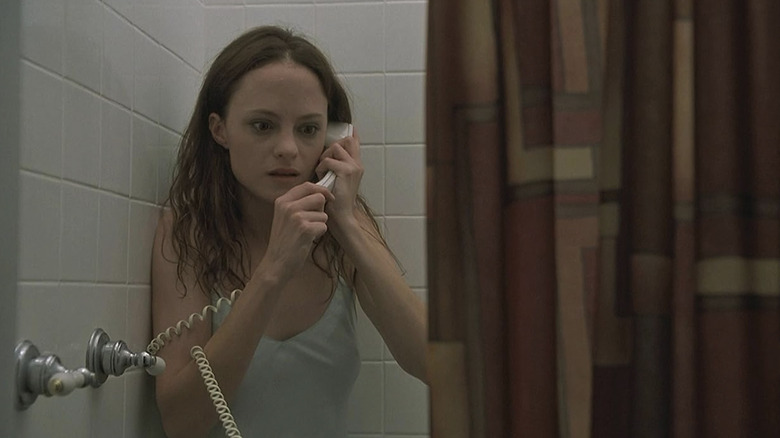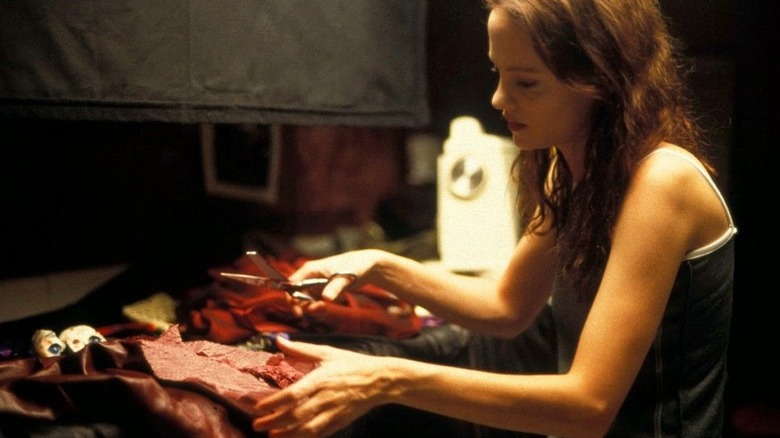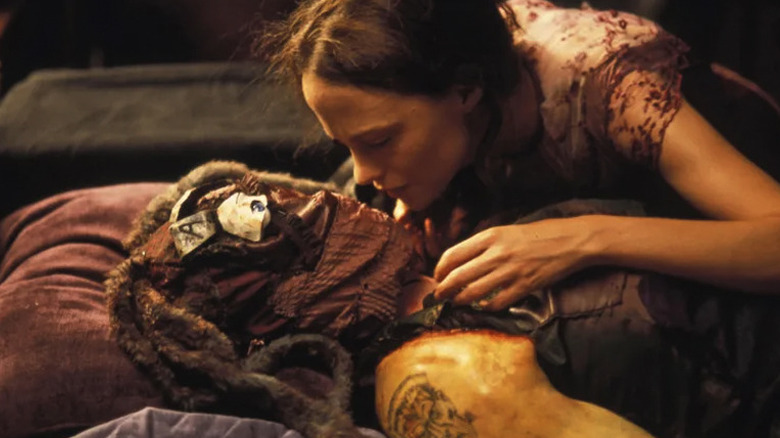Lucky McKee's Horror Gem May Went From Overlooked To Modern Classic
"If you can't find a friend, make one," a mother says to her child on her birthday, after gifting her a glass-encased Doll named Suzie. This child, May (Angela Bettis), finds herself struggling to make friends due to her amblyopia, or lazy eye, and finds herself clinging to Suzie for company and some sense of solace. This premise forms the foundation for Lucky McKee's directorial debut, "May," whose journey from being a box office flop to a cult classic over the years is as intriguing and strange as McKee's indie horror itself. The film has all the markings of unconventional body horror, with a good amount of psychological complexity thrown in for good measure. 21 years after its release, "May" still works as a weird little film about acute loneliness, and how this lingering feeling shapes us to covet parts of a whole.
When "May" was released in only nine theaters in North America, it only managed to gross around $150,277 against its $1.7 million budget. In purely economic terms, this can be considered a commercial flop. However, thanks to home video and favorable reviews from critics over the years, audiences gradually began to see "May" as the overlooked gem it is. There is something deeply relatable about the protagonist, even though she indulges in violent extremes, as it is a tale about a young woman who simply wants to be seen.
Even raging extroverts often feel the blow of crippling loneliness from time to time, where the walls close in as they recede into their darkest corners. For those who've struggled with perennial loneliness and social awkwardness, "May" symbolizes something deeply personal, as it unfurls the journey of someone who has never enjoyed the spotlight in their life, but also harbors a deep, insatiable hunger for it.
Making friends in a lonely world
McKee establishes May's personality through how little she asserts herself, where she is often invisible or someone who watches on, unnoticed, from the periphery. Her incredible social awkwardness constantly edges up to the line of being strange, but she seems sweet and harmless nonetheless, only yearning to make a true friend. However, May's relationship with Suzie is marked with odd boundaries and rules: The doll, who is her only friend, is never seen out of her glass case, and May can only rely on her silent presence without ever being able to hold her for comfort. As May transitions into adulthood, the facade of sweetness starts to crack, much like the glass case which holds Suzie.
The way people perceive May can be understood from two perspectives. Folks like her love interest, Adam (Jeremy Sisto), seem genuine enough at first, but they eventually shame May for her eccentric desires and discard her the moment they feel put off. On the other hand, people like Polly (Anna Faris) view May as a fragile, pretty doll to be played with, only to sideline her the moment they find a new distraction. These attitudes make May feel more unmoored and abandoned, and her previous hyper-fixations about people's body parts take on a more sinister meaning. There's a reason she only finds Adam's hands attractive or prefers Polly's neck — these are aspects she considers perfect puzzle pieces to stitch together a new persona for a friend she can truly relate to. In this case, this surgical fantasy takes on a more terrifying literal meaning.
Moreover, the human-doll dynamic in "May" is less of a sentient doll situation and closer to the transposed psyche condition in "Magic," where Anthony Hopkins' awkward magician uses his wooden puppet to navigate his repressed desires with horrible outcomes.
The price of complete isolation
The true merit of McKee's film does not simply lie in its ability to capture such a visceral emotion in unsettling ways. After all, there is no dearth of horror flicks that position a character with a troubled past and explore trauma manifestations along the way with standard genre trope flourishes. "May" is unique in the way it combines self-exile with a need to be understood, culminating in the Frankensteinian act of creating our own demons that meet a twisted standard of personal/societal "perfection." May is painfully aware of her flaws and yearns to be doll-like and perfect, just like Suzie. But when Suzie gets deformed, May uses violence to create another version of herself with "perfect" body parts of those around her.
While May's actions manifest in actions that are unforgivable, the base impulse behind them is a need to be loved and accepted. To be deprived of this basic human feeling and then be suddenly bombarded by fleeting promises that are eventually broken is undoubtedly cruel. Adam is a bit of a complicated case here: He is, by no means, unkind on purpose, as he truly seemed to enjoy her awkwardness as something sweet and endearing. It is only when May pushes Adam too far, by indulging in an impulse shaped by her trauma, that he shuns her completely and is honest about his feelings. It's hard to fault Adam, but for May, it is yet another betrayal, and a need to achieve perfection by any means possible.
Thus begins an obsession to see people in parts, and never as they truly are. This is how Amy is born, both a natural abomination and a tragic miracle — just like Frankenstein's monster — with May playing the dual parts of creator and creation.


